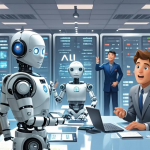At the end of 2024, Cursor completed a $100 million funding round with a valuation of $2.6 billion, seeing its value increase six and a half times in just four months. This signifies that AI applications in the coding domain are garnering increased attention. Let’s delve into the trends of AI programming and analyze if it could be the first to achieve AGI.
The Flourishing AI Applications in Coding
AI applications in the coding scene are flourishing, with various AI programming tools sprouting up like mushrooms after a rain. These tools are making programmers more efficient, even helping to complete half of the coding tasks. Moreover, as large models transition from pre-training Scaling Law to inference, the capability of AI to write code is notably improving.
The Reason Behind AI Programming’s Popularity
AI programming has emerged as the hottest AI application track because it has achieved Product-Market Fit (PMF). It assists programmers in enhancing their efficiency, reducing repetitive tasks, and allowing more time for innovation and complex problem-solving. Additionally, when AI enables the creation of software directly from output, bypassing code, the market space expands exponentially.
Products to Watch in AI Programming
Several products are worth noting in the AI programming domain. Firstly, tools like Cursor, Github Copilot, and Claude3.5 Artifacts cater to professional programmers, aiding in increased efficiency and reduced redundancy. Secondly, tools like Bolt.new, Windsurf, Replit, and Vercel target average users, enabling even those without programming experience to create software and applications.
Challenges and the Future of AI Programming
The future of AI programming will face challenges such as addressing the issue of model hallucinations, improving long context understanding for complex demands, and exploring the boundaries of software engineering for high-quality software generation.
Despite the challenges, the future of AI programming is bright. As models and code applications evolve, we look forward to witnessing the release of better model capabilities, transforming into productivity for users. We also anticipate more individuals joining the code generation industry to propel AI programming forward.
Looking Forward to 2025
In 2025, we expect to see more bright spots and changes in the AI programming field. We anticipate better model capabilities, more sophisticated tools and products, and increased participation in the industry. We believe AI programming will be a significant driving force in future technological advancements, bringing more convenience and innovation to our lives.
Below is the formatted content for wordpress blog:
At the end of 2024, Cursor completed a $100 million funding round with a valuation of $2.6 billion, seeing its value increase six and a half times in just four months. This signifies that AI applications in the coding domain are garnering increased attention. Let’s delve into the trends of AI programming and analyze if it could be the first to achieve AGI.
The Flourishing AI Applications in Coding
AI applications in the coding scene are flourishing, with various AI programming tools sprouting up like mushrooms after a rain. These tools are making programmers more efficient, even helping to complete half of the coding tasks. Moreover, as large models transition from pre-training Scaling Law to inference, the capability of AI to write code is notably improving.
The Reason Behind AI Programming’s Popularity
AI programming has emerged as the hottest AI application track because it has achieved Product-Market Fit (PMF). It assists programmers in enhancing their efficiency, reducing repetitive tasks, and allowing more time for innovation and complex problem-solving. Additionally, when AI enables the creation of software directly from output, bypassing code, the market space expands exponentially.
Products to Watch in AI Programming
Several products are worth noting in the AI programming domain. Firstly, tools like Cursor, Github Copilot, and Claude3.5 Artifacts cater to professional programmers, aiding in increased efficiency and reduced redundancy. Secondly, tools like Bolt.new, Windsurf, Replit, and Vercel target average users, enabling even those without programming experience to create software and applications.
Challenges and the Future of AI Programming
The future of AI programming will face challenges such as addressing the issue of model hallucinations, improving long context understanding for complex demands, and exploring the boundaries of software engineering for high-quality software generation.
Despite the challenges, the future of AI programming is bright. As models and code applications evolve, we look forward to witnessing the release of better model capabilities, transforming into productivity for users. We also anticipate more individuals joining the code generation industry to propel AI programming forward.
Looking Forward to 2025
In 2025, we expect to see more bright spots and changes in the AI programming field. We anticipate better model capabilities, more sophisticated tools and products, and increased participation in the industry. We believe AI programming will be a significant driving force in future technological advancements, bringing more convenience and innovation to our lives.


